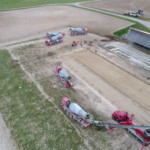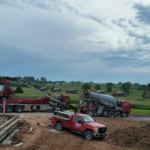Quick Guide to Concrete Flatwork Troubleshooting
Blisters

Blisters are bubbles or irregularly raised areas appearing in thin layers or bulges in a concrete slab surface. Blisters most often occur during the second or third pass of a mechanical finishing operation, as air is forced ahead of the trowel blade and under the “skin” of the concrete slab. Early finishing, lack of sufficient vibration of the placed concrete, or over-finishing can contribute to blistering of the concrete slab surface.
Cracking

Concrete contracts (shrinks) as it hardens and in cold temperatures, and if it is restrained from moving, the resulting stress is often relieved by the formation of cracks. Cracks can also form due to poor subgrade preparation, subgrade movement or uneven subgrade settlement, hydrostatic (water) pressure, or heavy loads applied to the slab (more than the concrete was designed for).
Crazing Cracks

Also known as “alligator,” “random,” or “map” cracking, crazing creates fine, hairline cracks in the surface of a hardened concrete slab. Crazing cracks are surface shrinkage resulting from excessive floating or troweling and or rapid drying of the surface – usually due to a combination of two or more weather conditions (wind, high temperatures, low humidity). A high slump concrete mix, excessive bleed water, premature troweling, improper addition of water to the mix on the job site, and poor curing practices (wet/dry curing cycles) can also contribute to the formation of crazing cracks.
Delamination

In a delaminated surface, the top 1/8″ is densified and separated from the base slab by a thin layer of air or water. Similar to blisters, delamination defects on the surface of a slab may range from several square inches to many square feet. Delamination occurs if the fresh concrete surface is sealed by troweling while the underlying concrete is still bleeding or able to release air. Delamination is more likely to form if: the underlying concrete sets slowly because of a cool subgrade; set properties of the concrete mix are retarded; improper use of a jitterbug or vibrating screed brings too much mortar to the surface; a dry shake is used, particularly with air entrained concrete; the concrete mix is sticky; or the slab is placed directly on a vapor barrier.
Discoloration

Color changes in hardened concrete can be caused by many factors, including: variations in slump from load to load; sprinkling dry cement on the wet slab surface; over-troweling with a steel trowel; delayed, hard-mechanical troweling; laying plastic or mats directly on the surface of the slab while the concrete is in its plastic (wet) state; use of calcium chloride (cc) in some (but not all) batches for the same project (or varying amounts of cc from batch to batch; or using different concrete materials (cement, admixtures, aggregates) in various batches for the same project.
Dusting

Dusting produces a soft, easily scratched concrete slab surface that erodes easily under traffic, producing a powdery, chalky material on the dry surface of the hardened concrete. Many factors can contribute to dusting, including excessively high-slump concrete, premature finishing, condensation of warm, moist air over cool concrete, an over-abundance of “fines” in the sand used to make the concrete, and carbonation due to improper ventilation of exhaust from heaters or vehicles in enclosed areas.
Plastic Shrinkage

Plastic shrinkage cracks occur when the rate of evaporation is greater than the movement of water to the slab surface from within the concrete. Rapid evaporation of water from the surface of the concrete due to high temperatures combined with low humidity and windy conditions can cause plastic shrinkage cracks, as can concrete with high internal temperatures.
Popouts

Popouts are indentations in a concrete slab surface created when porous aggregate (sand, gravel, or crushed stone) picks up moisture, freezes, expands, and fractures, taking a portion of the concrete slab surface mortar with it. Popouts do not decrease the service life of a concrete slab, but a significant number of popouts can be unsightly. Chert is a porous aggregate found to some degree in all aggregate deposits used to produce concrete in Southeastern Wisconsin. Given the available raw materials in this portion of the state, popouts are inevitable, as chert-free concrete mixes are not possible. Low chert aggregate materials are available in Southeastern Wisconsin, however, and do minimize the potential for popouts.
Scaling

Scaling is disintegration of a hardened concrete surface where the concrete surface peels or flakes off, or chips away in thin layers. Repeated freeze thaw cycles in non (or insufficiently) air-entrained concrete and misuse of deicing chemicals are the chief causes of scaling. An overly wet mix, adding excess water to the mix at the job site, porous aggregates, and faulty workmanship – including finishing the concrete while bleed water is on the surface or over-finishing with the darby or float – can also cause exterior concrete flatwork to scale.
Spalling

Spalling is the sloughing or flaking off of fragments of the concrete, most generally caused by mechanical or expansive forces at or near the surface of the concrete slab that act along or create a weakened plane. Expansive forces can be caused by the stress of corrosion of reinforcing steel or imbedded metal items or by moisture trapped inside the concrete matrix by paints or sealants, which prohibit moisture from escaping. Mechanical forces most often involve a physical blow to the concrete, for example a plow blade hitting a concrete curb or approach. Spalling can also occur due to laitance, a condition most often related to high slump concrete, where a cement-rich paste rises to the surface of the slab during placement and finishing, depriving other sections of the mix of cement-related cohesion and consolidation.










